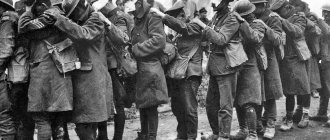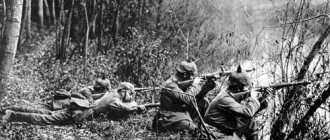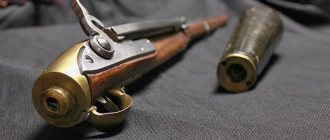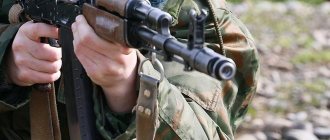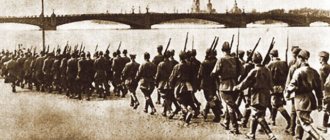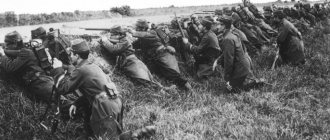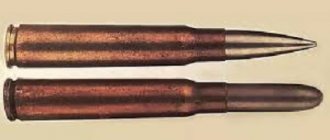Successes amid failures
After 1915−1916, the British who commanded the operation did not put all their forces into one strike. The Entente command divided the operation into several stages. The first step was the Messinian operation. The goal is to cut off the dangerous German ledge, which rests on the ridge of the same name and wedges 10 km into the British positions. A lot on the scale of the First World War, where the transitions were on foot.
Canadians in positions in Europe. (Wikimedia Commons)
The British were very well prepared for the operation: tanks and aircraft were actively used, and underground explosive work was carried out on a large scale. In particular, at this time the most powerful non-nuclear explosion in history was carried out. Thanks to all this, the Allied troops completed the task with relative ease.
The First World War was a confrontation between rival industries. (pinterest.com)
The success in the Messina operation and relatively small losses (2 divisions out of 12) inspired both the soldiers and the command. Moreover, to the south, between Reims and Arras, one of the biggest failures of the Entente in the entire war took place - the Nivelle Massacre. So, the first stage of the third Battle of Ypres was successful and on July 31, 1917, a new offensive began, the goal of which was the heights near the village of Passchendaele.
References
- ↑ James Ellis and Michael Cox, World War I Databook
- Fernandez, Ivo Xavier (1941). Place names and pagans
.
I
. Porto: Editora Educação Nacional, Lda. - Edmonds 1948, pp. 22–25.
- Terrain 1977, for. 336.
- Edmonds 1948, pp. 124–125.
- Terrain 1977, for. 299.
- Prior & Wilson 1996, for. 179.
- Davis, Edmonds and Maxwell-Hislop, 1937, for. 138-452.
- Edmonds and Maxwell-Hislop, 1947, pp. 57–93.
- Edmonds and Maxwell-Hislop, 1947, pp. 269–293 and 426–453.
- Terrain 1977, pp. 159–163 and 198–199.
- Terrain 1977, for. 111.
- Edmonds 1948, for. 106.
- Sheldon 2007, for. 315.
- Prior & Wilson 1996, pp. 194–200.
Battle of Ypres: a fatal mistake
It was here that the British made a mistake that became fatal. The attackers paused for almost a month between Messina and the continuation of the offensive, despite the warnings and entreaties of many commanders. The commanders-in-chief launched complex combinations and reshuffling of forces from Ypres to Arras, trying to distract the Germans. Those, however, did not fall for the invention and got a break.
Rest of soldiers between battles in Flanders. (eurocomunicazione.com)
During a month of rest, the Germans managed to strengthen their defenses. The artillery battle was almost equal: the British had a numerical superiority, and the Germans had guns beyond the reach of the British, in the rear. Moreover, the Germans managed to position positions on the reverse slopes and camouflage them well. Even aerial reconnaissance did not really help the British.
Events of 1915 in the Balkans
Bulgaria was expected to enter the war on the side of the Central Powers. Then sparsely populated Serbia with a small army would be surrounded by enemies on two fronts, with inevitable military defeat. Russia could not help, since neutral Romania refused to let Russian troops through. On October 5, the offensive of the Central Powers from Austria-Hungary began; on October 14, Bulgaria declared war on the Entente countries and began military operations against Serbia. The troops of the Serbs, British and French were numerically inferior to the forces of the Central Powers by more than 2 times and had no chance of success.
By the end of December, Serbian troops were forced to leave the territory of Serbia and go to Albania, but the personnel of the Serbian army (up to 150 thousand people) were retained and in the spring of 1916 they strengthened the Thessaloniki Front.
The accession of Bulgaria to the Central Powers and the fall of Serbia opened up direct land communication for the Central Powers with Turkey.
New weapon: Mustard gas
At the same time, a new chemical weapon was used - mustard gas, also known as “mustard gas” or “yellow cross” - this is how the Germans marked chemical shells with this gas. Mustard gas, unlike chlorine and other precursor gases, affected humans both when inhaled and when it came into contact with the skin. Now the soldiers needed full body protection.
Legendary photograph of blinded mustard gas victims. (gettyimages.co.uk)
In addition, the effect of mustard gas on the skin did not manifest itself immediately, so soldiers easily received large doses of infection. Losses from mustard gas turned out to be unexpectedly high even for the Western Front, accustomed to chemical attacks. However, against the background of general losses, losses from mustard gas seem small.
By the end of July, the Allies had made significant progress towards Pandale and crossed the Isère River. But the battle plan was already falling apart. Yes, the Germans suffered heavy casualties, but they retained their artillery and, retreating, removing the main forces from the attack, they held the front and did not allow the troops to be destroyed.
Battlefield, autumn 1917. (abc.net)
Since July 31, the Entente has been hitting the German defenses, trying to find gaps in it. Four offensives were organized. Heavy artillery fire alternated with infantry attacks. At least the Germans counterattacked and fought off the British. The opponents clashed in a positional struggle, and the battle fell apart into many small battles in a labyrinth of trenches. German counterattacks and chemical warfare are commonplace in this war. What was new was a huge amount of dirt.
Western Front
The beginning of 1915 was marked by a significant decrease in the intensity of hostilities on the Western Front. Germany was intensively preparing for battles against Russia. In the first four months of the new year, there was almost complete calm at the front; fighting took place only in the historical region of France, Artois and southeast of Verdun.
D. Richards "Second Battle of Ypres, 22 April to May 1915"
The Germans launched a counterattack against British troops in the north of the front, in Flanders near the city of Ypres . Three major battles took place on the Ypres salient, during which in 1915 the Germans used chemical weapons - chlorine - for the first time in history. And in 1917, mustard gas, now known as mustard .
15 thousand people were affected, of which 5 thousand died. After the Ypres gas attack, both sides quickly developed gas masks of various designs.
Menin Gate. The author of the project is R. Bloomfield
The Menin Gate (1927) is a triumphal arch, a monument in the Belgian city of Ypres, dedicated to the memory of soldiers and officers of the Entente forces who died in the battles of the First World War near this city and whose bodies were not found. The monument was built with funds from the British government.
The names of the 54 thousand who died in these places during the First World War are engraved on the monument. In total, there are at least one hundred and forty war cemeteries and memorials around the city.
Throughout 1915, the front was practically not broken through, except for the movement of the front line by 10 km. But at the same time, there were huge casualties on both sides.
Then Germany decided to direct all its efforts to the Eastern Front, to fight Russia.
At the same time, the military actions of early 1915 showed that such warfare creates an unbearable burden on the economies of the warring countries: millions of people were mobilized, there was a shortage of weapons and ammunition. Pre-war reserves were quickly exhausted, so the warring countries began to hastily rebuild their economies for military needs. The war began to turn into a battle of economies. The development of new military equipment intensified - all these actions were to the detriment of the peaceful existence of people.
Use of aviation
At the beginning of the war, aviation was used mainly only for aerial reconnaissance, but after some time it began to be used as a military weapon.
Pyotr Nikolaevich Nesterov
The first to use the aircraft in battle was the Russian pilot Pyotr Nesterov . On September 8, 1914, he shot down an enemy plane using a ram, killing himself. Nesterov installed a “knife-file” in the tail of the airplane to destroy the shell of the airship, and to destroy the propeller of an enemy aircraft, he attached a long cable with a load at the end in the form of a “cat”.
Seven months after the death of P. Nesterov, in March 1915, his air ram was used by Lieutenant A. A. Kazakov . He landed safely after the attack.
Alexander Alexandrovich Kazakov
On April 1, 1915, the French pilot Roland Garros used a machine gun located behind the main rotor for an air attack. Soon his plane was shot down and handed over to the Dutch engineer Anthony Fokker , who improved its design by using a synchronizer that made it possible to fire a machine gun through the propeller disk when its blades were not in the line of fire. This development was used in the Fokker EI fighter, the first high-speed single-seat fighter with effective weapons.
Fokker E.I.
The First World War spurred the development of aviation. Aircraft production began to grow at a high rate: if at the beginning of the war England and France had 186 aircraft, Germany and Austria-Hungary - 297, then by the end of the war they had 5079 and 3352 aircraft, respectively.
In September, a major Allied offensive began - the Third Battle of Artois: French troops in Champagne and British troops in Los. During the summer, the French made preparations for a future offensive, and on September 22, they began bombing targets that were identified using aerial photography. The main offensive began on September 25. It developed successfully, but the Germans strengthened their defense lines and were able to repel the attack, which lasted until November.
French aerial photography. French aviator Jean Navard, who shot down 14 German airplanes, found an original camera device for taking pictures from airplanes on one of them, which fell in the vicinity of Soissons. Based on this model, the French began to make the same devices
Eastern front
Winter 1915
The Russian army attempted an attack on East Prussia from the southeast, from the city of Suwalki. But the offensive was not supported by artillery and quickly fizzled out. German troops launched a counterattack, launching the Augustow Operation in the area of the city of Augustow. As a result, they ousted Russian troops from the territory of East Prussia and advanced deep into the Kingdom of Poland, capturing Suwalki. After this, the front stabilized. And although the city of Grodno remained with Russia, the 20th Russian Corps was almost completely destroyed.
However, the Germans counted in vain on the collapse of the Russian front - during the Prasnysz operation (February-March), there was fierce resistance from Russian troops, which turned into a counterattack in the Prsasnysz area. The Germans were forced to retreat to the pre-war border of East Prussia.
The winter operation in the Carpathians took place on February 9-11, in which the Russians lost most of Bukovina with Chernivtsi. But on March 22, the besieged Austrian fortress of Przemysl fell, and more than 120 thousand people surrendered. This was the last major success of the Russian army in 1915.
Retreats of the Russian armies: the loss of Galicia
By mid-spring the situation at the front in Galicia had changed. Germany transferred its troops to the northern and central part of the front in Austria-Hungary, and the Austro-Hungarians were responsible only for the southern part. Russian troops were outnumbered by 2 times, were completely deprived of heavy artillery, and lacked main (three-inch) caliber shells. On May 2, German troops launched an attack on the center of the Russian position in Gorlitsa, planning to deliver the main blow to Lvov. On May 5, the front in this area was broken through. The retreat of the Russian armies began, which continued until June 22 - this was the so-called Great Retreat of 1915. The front passed through Lublin (behind Russia); Most of Galicia, newly taken Przemysl, and Lvov were abandoned. Russian troops retained the entire region of Tarnopol and part of Bukovina. This military failure could not help but break the fighting spirit of the soldiers, and surrenders began. General A.I. Denikin wrote about this in his book of memoirs “Essays on Russian Troubles”:
“The spring of 1915 will remain in my memory forever. The great tragedy of the Russian army is the retreat from Galicia. No cartridges, no shells. Bloody battles day after day, difficult marches day after day, endless fatigue - physical and moral; now timid hopes, now hopeless horror..."
Brusilov and Grand Duke Georgy Mikhailovich during the Great Retreat of 1915
But the strategic plan to defeat the Russian armed forces failed. On August 23, Nicholas II took command of the army, and this led to positive changes in the situation at the fronts. Before this, Minister of War V.A. Sukhomlinov was replaced by A.A. Polivanov. Grand Duke Nikolai Nikolaevich was transferred to the Caucasian front. The actual leadership of military operations passed from N. N. Yanushkevich to M. V. Alekseev.
Nicholas II takes command of the army
In the fall of 1915, the Russians avoided encirclement by responding with a series of counterattacks. The front has stabilized on the line Riga - Dvinsk - Baranovichi - Pinsk - Dubno - Tarnopol. Russia began to rebuild its troops, which were badly damaged during the retreat, and strengthen new defensive lines.
By the end of 1915, the front had become almost a straight line connecting the Baltic and Black Seas; Poland was completely occupied by Germany. The new front line was filled with troops from both sides, leading to trench warfare and defensive tactics.
Camouflaged machine gun
At the beginning of the war, Italy remained neutral. But on April 26, 1915, the London Pact was concluded, according to which Italy pledged to declare war on Austria-Hungary within a month and oppose all enemies of the Entente. For this, Italy was promised a number of territories. England provided Italy with a loan of 50 million pounds. On May 23, Italy declared war on Austria-Hungary.
A lot of dirt
The pervasive dirt is a symbol of the First World War. Millions of shells fired into the same places over many weeks destroyed all irrigation systems and disrupted groundwater flows. In the conditions of Flanders, in marshy areas, the effects of artillery shelling were felt very well. A huge amount of water came to the surface, turning everything into one continuous mud.
Tanks stuck in mud, 1918. (pinterest.com)
The area near Ypres is swampy and extremely dependent on artificial drainage; on top of that, extremely cloudy weather is common in this region. In the summer it was still tolerable, but with the onset of October and the onset of rains, the battlefield turned into a swamp. A soldier could step on a seemingly ordinary puddle and drown under the weight of his equipment in an explosion crater hidden by water. The wounded were choking, unable to get out of the battlefield.
British engineers in Flanders. (pinterest.com)
The mud deprived the Entente of its main trump card - tanks. They simply couldn't get through. Supply, evacuation and generally any actions in such conditions turned out to be practically impossible. Therefore, the third Battle of Ypres was given the eloquent nickname “The Battle of the Mud.”
Ypres, autumn 1917. (4thyorkshires.com)
The Battle of Ypres: the result of a fight in the mud
In October, the offensive stalled, but at the end of the month, on the 30th, Canadian units, with the support of the British, still managed to capture Passchendaele. The Entente advanced 6-8 kilometers in the Ypres area. This advance cost approximately 500,000 British soldiers killed and wounded. The Germans lost about 250 thousand people. The exact numbers are still unknown. It is worth noting that a lot of soldiers of the British dominions took part in the Battle of Passchendaele - by this time the flower of the British nation was simply wiped out by the war.
Battle of the Marne
French soldiers are waiting for the assault. Photo: Agence Rol/Public domain. Date: September 5 - 12, 1914 France and Great Britain against the German Empire. After the disaster in the Ardennes, the French were in a difficult situation, their English allies showed themselves to be an unreliable help. The Germans meanwhile confidently approached Paris. The capital would almost certainly have fallen as a result of this campaign, but the German Empire simply did not have enough strength to complete the offensive. Reinforcements were bogged down on the Eastern Front and the Germans were forced to maneuver, looking for the best way to hurt the enemy. The maneuvers led to a fatal turn and on September 5, near the Marne River, the Germans opened their rear and flank to their opponents, where the combined Anglo-French troops struck with the desperation of a cornered beast.
Map of the Battle of the Marne. Photo: Vitor / CC BY-SA (https://creativecommons.org/licenses/by-sa/3.0). The result of the counteroffensive was the Miracle on the Marne, as the French call it, for whom the seven-day battle restored self-confidence and a victorious mood, lost by constant defeats to their sworn neighbors the Prussians. In addition to the psychological turning point and the changed balance of power, another result of the Marne 1914 (there will also be the Marne 1918) was the crushing blow received by the German Empire, which lost a quarter of a million of its best soldiers and retreated tens of kilometers.
